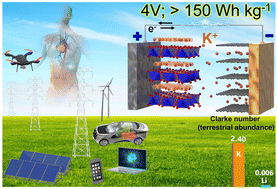Advancements in cathode materials for potassium-ion batteries: current landscape, obstacles, and prospects
Abstract
The development of advanced energy storage technologies has assumed paramount significance in addressing the escalating demands for sustainable and eco-friendly power sources. Amongst these innovative technologies, potassium-ion batteries (KIBs) have risen to the fore as viable contenders, chiefly owing to their cost-effectiveness and the abundant availability of potassium resources. Nevertheless, the realisation of efficient and high-performance KIBs hinges significantly upon the adept design and appropriate utilisation of cathode materials. Thus, this Perspective provides a comprehensive analysis of the present status, associated challenges, and prospective avenues concerning cathode materials for KIBs. We commence by discussing the significance of KIBs in the context of the global energy landscape and highlight their potential to revolutionise energy storage systems. Subsequently, we delve into cathode materials for KIBs, emphasising their pivotal role in determining the overall performance of these batteries. A systematic survey of the various cathode materials explored to date is presented, primarily encompassing layered oxides, polyanion-based compounds, Prussian analogues and organic moieties. The discussion focuses on the advantages, limitations, and performance metrics of each material class, unveiling the critical insights gained from experimental studies and theoretical investigations. Furthermore, this Perspective sheds light on the prominent challenges and obstacles hindering the widespread adoption of KIBs. These challenges include issues related to limited specific capacities, sluggish kinetics, and performance attenuation during cycling, as well as the scarcity of suitable electrolytes. We offer an authoritative evaluation of the efforts undertaken to address these obstacles, including novel material design strategies, advanced characterisation techniques, and the integration of nanotechnology. Finally, we conclude with a forward-looking perspective, outlining the future directions and potential breakthroughs in electrode materials for KIBs. We emphasise the importance of interdisciplinary collaborations, advancements in computational methods, and fundamental research to foster the development of high-performance and environmentally sustainable KIBs. In conclusion, this Perspective consolidates the current state of electrode materials for KIBs whilst elucidating the challenges that need to be overcome to unlock their full potential. By synthesising the collective knowledge from the latest research endeavours, this Perspective aims to inspire future research and innovation in the pursuit of efficient and scalable KIB technologies.

- This article is part of the themed collections: Solid-state batteries, Research advancing UN SDG 7: Affordable and clean energy, Energy Advances Recent Review Articles and Energy Advances: Highlight Japan & South Korea


 Please wait while we load your content...
Please wait while we load your content...